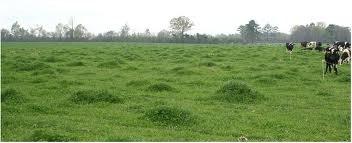February 2013
VIEWPOINT
with John Barnes, Managing Director – February 2013
Chemicals Not The Answer
This year has started off with some amazing revelations even for someone like myself (four of our most senior staff have 70 years experience in the fertiliser industry between us), so when the topic of finding DCD in our milk arose, it took us all by surprise.
Sooner or later we knew this would happen because fixing a chemical problem with yet another chemical would eventually lead to detecting some sort of chemical getting into the system.
As the world quite rightly wants to know, “Is our milk safe to drink?” – (Sunday Star Times). My answer to this question is still a resounding ‘Yes’ but I would have to temper this with – ‘for how long?’
We cannot keep this chemical system going for ever. New Zealand must take a check on all of this and think of new and better systems.
The overseer programme is a step in the right direction, but is too biased toward chemical fertilisers to be of any help. In the past, this programme had a useful section on natural phosphate, but for their own reasons, it was removed and replaced with a token programme which limits any other products that are not acid-based and water soluble.
Acid-based products can and probably will kill the tiny microbes in our soils which is a real shame because these little creatures are responsible for carrying the applied fertiliser from the soils into the root system of the plant.
Water soluble means the elements in the fertiliser will be easier to leach into our waterways which will then mean they will find their way into the food chain. This is the very reason we get headlines in our papers and indeed in the world papers about leachable fertiliser products. It also raises the question on how clean and green we are.
In this edition of Viewpoint we will take a quick look at our soils and carbon, a bit about root structures and foliar feeding for autumn growth.
The choice is yours – but not for long!
We have been talking about the differences between chemical farming and biological farming for quite some time now and most will think this is quite a recent debate – well, it isn’t. This discussion started in the 1850s, 160 years ago, and it makes fascinating reading.
Just Google Bread from Stone or download this pdf file.
The publication relays the account of two scientists with opposing views. One believed and proved that natural fertilisers worked and improved fruit quality. The other scientist manufactured what we now call Superphosphate – the Super group had more money than the natural fertiliser group and then proceeded to put this team out of business – burnt their books and publically humiliated them.
If this all sounds familiar – it is. We still have the two sectors and the Super group haven’t changed their stance in over five generations. All this could be quite funny if it wasn’t for the fact that in a recent Sunday Star Times the front page reads “The World asks: Is NZ milk safe to drink”? How did this all happen? The Super group believe that chemicals will fix everything. If there is a chemical problem then another chemical will fix it.
Dairy farmers typically use about 500kg of Urea per hectare at a cost of $425.00. That equates for a 200ha farm a cost of $85,000.00. Now because a 200 hectare farm uses just under 100 tonne of Urea per year, there will be serious soil degradation.
And before we go any further, let us work out who suggests the use of this amount of Nitrogen. It is the Industry Advisors who are ruthless in their campaign to lift production using only one tool (Nitrogen) spurred on by the two Superphosphate companies. Because of this pollution, which the farmers get blamed for, they (the Advisors) now suggest yet another chemical worse than the last – DCD. DCD (Dicyandiamide) is a product that is supposed to block Nitrogen from leaching into the waterways.
But the cure is now worse than the problem. This DCD has now found its way into our food chain via the milk and can cause human health problems, but all is not lost. There are other ways of growing grass in a sustainable way and without leaching Nitrogen into the waterways, which is why I set up Fertilizer New Zealand in the first place.
If you are looking for a sustainable farming system that will be economical, then call us today on 0800 337 869.
Liquid Fertilisers – Do they Work?
This the debate we have had for years. There is evidence on farms that a little bit of nutrient goes a lot further in a liquid suspension. Work from universities show that the difference is 4 to 1. Four times the elements need to be applied to the soil than need to be applied in liquid form. The most common liquid fertiliser is the dairy cows urine.
Check out this picture…

The cows urine patch will grow an amazing amount of pasture while the surrounding pasture remains stunted. This makes a very good argument why farmers should use liquids at suitable rates of nutrient to grow grass.
A Glimpse into the Dilemma
Farmers of all persuasions today are bombarded with mixed messages on a grand scale. No longer is their value publicly recognised as it once was when farmers could truly say they were doing “God’s work” producing food for the world.
They still are, of course, but media and the electronic communications of today have diluted the work of the good and highlight the nonsense of the celebrity. But there you go, that is life!!
Over 80% of New Zealand’s exports are from agriculture and that will not change anytime soon, even though many may try to over hype some new widget or other and promote that as the coming of a new age.
Agriculture is what we do and it is still feeding the world.
The international “greening” of the expectations and demands of city dwellers mean that farmers once again need to adjust to the market. Consumers want to feel good about what they are eating and want to be reassured that the environment is being looked after as well. This all falls to the farmer to sort out.
It is not scary and it is not new, it is just different and we need to look at these issues critically and come up with simple inexpensive answers which are in fact available. In most cases they are well proven, simple and effective. But they have been forgotten. We need to go back to basics – but with modern technology.
Lessening our reliance on chemicals is something that consumers definitely want. We can show you how to attain these seemingly conflicting goals and grow all the grass and crops you will ever need and at the same time keep the consumers happy.
Fertilizer New Zealand can help you through the dilemmas of modern agriculture so give us a call.
Drought
This time of the year can be a challenge for the most experienced farmer. High summer temperatures and the lack of rain can cause vast devastation.
All is not lost because there are many areas where Fertilizer New Zealand can help, as our farmer clients can testify. Why is it that clients who use our full programme are getting great results? Results like grass growing when their neighbour’s grass has stopped and, in cases, burnt off. Others with irrigation who use less water than the district average on the same soil type grow the same amount of grass. Their farms have a greater profit because their inputs are lower.
It is because our staff takes the time to dig holes and show our clients the reason for good soil structure. Soils should be living and breathing. If they are not, there is a major problem. The best soil test you will ever do is to visually assess the soil. It should be 40% parent material, 25% water, 25% air and at least 5% organic matter. Now, I also realise this will change from area to area but this is a good start. Give us a call or email us and we will send someone out to help you with this.
Many of the soils I check lack air, which is one of the key ingredients for growing healthy plants. To get air into the soils there needs to be less compaction. Acid fertilisers tend to burn carbon, whereas RPR-based fertilisers restore carbon. Over the next few months we will look at how this happens and the various microbes which work on the soil.
VitaLife is one of our core products and is designed to lift carbon levels in the soil. By lifting the carbon levels in the soil, it will also increase the water holding capacity of the soil, in much the same way as a sponge holds water.


